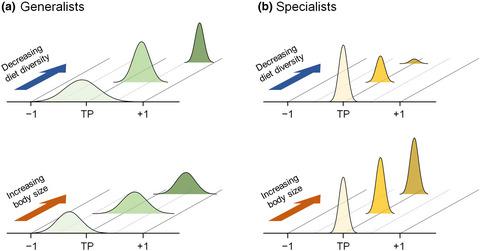当前位置:
X-MOL 学术
›
Ecol. Evol.
›
论文详情
Our official English website, www.x-mol.net, welcomes your
feedback! (Note: you will need to create a separate account there.)
Trophic response to ecological conditions of habitats: Evidence from trophic variability of freshwater fish.
Ecology and Evolution ( IF 2.3 ) Pub Date : 2020-07-03 , DOI: 10.1002/ece3.6451 Bohyung Choi 1, 2 , Changhwa Lee 1 , Yuko Takizawa 2 , Yoshito Chikaraishi 2, 3 , Hye-Ji Oh 4 , Kwang-Hyeon Chang 4 , Min-Ho Jang 5 , Hyun-Woo Kim 6 , Kyung-Lak Lee 7 , Kyung-Hoon Shin 1
中文翻译:

对栖息地生态条件的营养反应:淡水鱼营养变异的证据。
更新日期:2020-07-30
Ecology and Evolution ( IF 2.3 ) Pub Date : 2020-07-03 , DOI: 10.1002/ece3.6451 Bohyung Choi 1, 2 , Changhwa Lee 1 , Yuko Takizawa 2 , Yoshito Chikaraishi 2, 3 , Hye-Ji Oh 4 , Kwang-Hyeon Chang 4 , Min-Ho Jang 5 , Hyun-Woo Kim 6 , Kyung-Lak Lee 7 , Kyung-Hoon Shin 1
Affiliation

|
- To adapt to ecological and environmental conditions, species can change their ecological niche (e.g., interactions among species) and function (e.g., prey‐predation, diet competition, and habitat segregation) at the species and guild levels. Stable isotope analysis of bulk carbon and nitrogen of organisms has conventionally been used to evaluate such adaptabilities in the scenopoetic and bionomic views as the isotopic niche width.
- Compound‐specific stable isotope analysis (CSIA) of nitrogen within amino acids provides trophic information without any disruption of scenopoetic views in the isotope ratios, unlike conventional bulk isotope analysis provides both information and therefore frequently hinders its usefulness for trophic information.
- We performed CSIA of amino acids to understand the trophic variability of the pike gudgeon Pseudogobio esocinus and largemouth bass Micropterus salmoides as representative specialist and generalist fish species, respectively, from 16 ecologically variable habitats in the four major rivers of Korea.
- There was little variation (1σ ) in the trophic position (TP) among habitats for P. esocinus (± 0.2); however, there was considerably large variation for M. salmoides (± 0.6). The TP of M. salmoides was negatively correlated with the benthic invertebrate indices of the habitats, whereas the TP of P. esocinus showed no significant correlation with any indices. Thus, these two representative fish species have different trophic responses to ecological conditions, which is related to known differences in the trophic niche between specialists (i.e., small niche width) and generalists (i.e., large niche width).
- Over the past four decades, the conventional bulk isotope analysis has not been capable of deconvoluting “scenopoetic” and “bionomic” information. However, in the present study, we demonstrated that the CSIA of amino acids could isolate trophic niches from the traditional ecological niche composed of trophic and habitat information and evaluated how biological and ecological indices influence the trophic response of specialists and generalists.
中文翻译:

对栖息地生态条件的营养反应:淡水鱼营养变异的证据。
为了适应生态和环境条件,物种可以在物种和行会层面改变其生态位(例如,物种之间的相互作用)和功能(例如,猎物捕食、饮食竞争和栖息地隔离)。生物体大量碳和氮的稳定同位素分析通常用于评估同位素生态位宽度等场景学和生物组学观点的适应性。
氨基酸内氮的化合物特异性稳定同位素分析 (CSIA) 提供营养信息,而不会破坏同位素比率的场景视图,这与传统的大量同位素分析不同,它提供这两种信息,因此经常妨碍其对营养信息的有用性。
我们进行了氨基酸的 CSIA,以了解韩国四大河流 16 个生态可变栖息地的梭子鱼Pseudogobio esocinus和大口黑鲈Micropterus salmoides的营养变异性,分别作为代表专业鱼类和通才鱼类。
P. esocinus的栖息地之间的营养位置 (TP) 几乎没有变化 (1 σ ) (± 0.2);然而, M. salmoides的变异相当大 (± 0.6)。大鲑鱼的TP与生境底栖无脊椎动物指数呈负相关,而长叶对虾的TP与任何指数均无显着相关性。因此,这两种代表性鱼类对生态条件具有不同的营养响应,这与已知的专科鱼类(即小生态位宽度)和通才鱼类(即大生态位宽度)之间的营养生态位差异有关。
在过去的四十年中,传统的大量同位素分析无法对“场景”和“生物组学”信息进行去卷积。然而,在本研究中,我们证明氨基酸的CSIA可以将营养生态位与由营养和栖息地信息组成的传统生态位分开,并评估生物和生态指数如何影响专家和通才的营养反应。











































 京公网安备 11010802027423号
京公网安备 11010802027423号